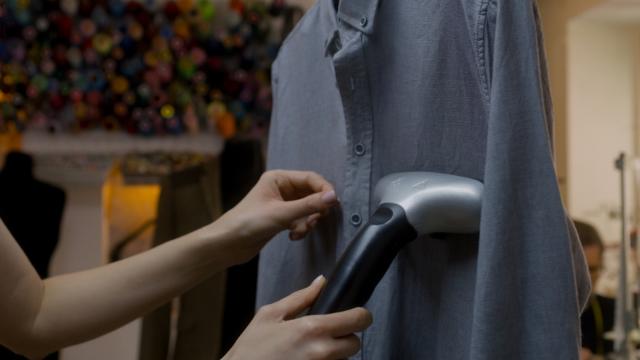A few years ago, I was stricken by inspiration and put some cheap perfume in my steamer, thinking it might make my clothes smell nice after I unwrinkled them. It didn’t work. Some time thereafter, I noticed crystals accumulating inside the steamer and concluded I must have messed it up with the perfume. This week, however, I came across some information that lifted my spirits: All steamers get crystals in them because of minerals in the water they heat up and expel, which means it wasn’t my idiot behaviour that caused the problem. Yay! Unfortunately, this means we have to clean the steamers regularly. Boo!
Cleaning a steamer isn’t actually that difficult. I learned as much when I rifled through my cabinets to find my long-abandoned, crystalized laundry tool. Here’s what I found.
How to clean a steamer
I read up on the process for a while and discovered that all you need to do is fill that bad boy with some vinegar—or so they say. Dutifully, I filled my steamer with distilled white vinegar, noticing immediately that some of the crystals floated to the top. Gross! You’re supposed to wait 20 to 30 minutes after that to allow the vinegar to really loosen the gunk in there, so I did. Leaving it unplugged in my sink, I let the vinegar get to work.
The next step is to plug it in, turn it on, and have the vinegar come out the spout, as water normally would. I assessed the situation and decided I didn’t want to have the crystals come through the nozzle, so I poured the vinegar down the drain and opted to refill it and vaporize the second round. To my dismay, it was still pretty mineralized in there, so I grabbed an old toothbrush and scrubbed. This had very little effect, which helped me realize why the second step of dispelling the vinegar through the nozzle is so important: It needs to get hot in there.
I refilled and turned the machine on. It heated up just how I remember it used to, God bless it, but the vinegar didn’t come out in a mist. Rather, it shot in streams all over my sink. I don’t know the science behind that, but it was a little scary, so bear in mind that you should keep close watch on your steamer when you complete this step. When it was done spouting, I opened it up… and saw minimal improvement. Granted, this steamer hasn’t been touched since 2019, the year of the perfume incident. It’s probably much worse off than yours. But how better to determine if the vinegar trick works than by cleaning a super-dirty one?
I scrubbed a little more with my toothbrush, then filled it for a third time and repeated the heating-and-dispelling process. This time, after some more vigorous scrubbing, I saw a major improvement. Vinegar does work to clean a steamer. I rinsed it and vowed to take a third pass at it later, when it cools down, but once you’re done running vinegar through the machine, don’t forget to fill the tank with water and dispel that, too, for a good rinse.

Credit: Lindsey Ellefson
How often to clean a steamer
In general, you should clean your steamer every two months to keep it running well. One reason I stopped using mine and got a new one was because it didn’t run nicely at all once I started noticing the crystals. The good news is I was wrong that there was nothing I could do about them. The bad news is that you will have to vinegar it up every two months (or monthly if you use it daily), and I won’t lie: It smells.
Use your judgment about how often to clean it if you aren’t sure, but always do it if it starts spitting water, you see visible crystals, or you’re going to use it for disinfecting purposes around the house.

Leave a Reply
You must be logged in to post a comment.